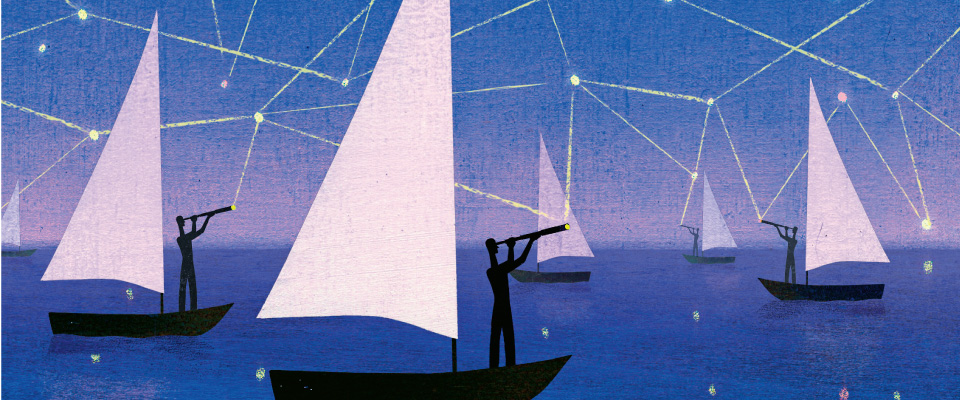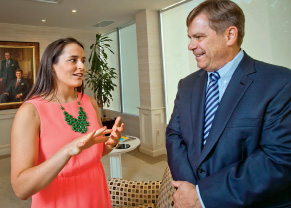Fluid Boundaries

By Kathleen Parrish | Illustration by Jon Krause
Ask Lafayette students how they connect what they learn in campus classrooms and labs to the broader world—and vice versa—and they’re apt to knit their brow in confusion, as if you’ve just confessed to, say, not owning a cell phone. To them, learning is 24/7, transcending walls. The classroom and the world are one.
“It’s porous,” says Renan Dincer ’16. “We don’t categorize school and life. School is life. You’re expected to bring outside experiences to class and add to the conversation.” To paraphrase the late Steve Jobs, it’s about being able to connect experiences and synthesize new things.
Abby Williams ’15 embraces that idea with gusto. When the dual-degree candidate in policy studies and neuroscience went to India two years ago with her family, she was shocked to see heaps of garbage on the ground and noticed that there were no trash receptacles.
“How do you incentivize people to pick up the trash?” she thought, reflecting on some of her coursework and professors as resources to help her explore the problem. “I knew there had to be an answer.”
She enrolled in a behavioral economics course and was inspired to find a solution. In an EXCEL Scholars research project with Mark Crain, Simon Professor of Political Economy and chair of policy studies, she began to explore anaerobic digestion, a process that turns organic waste into methane, which can be converted to natural gas to power generators for electricity. She adopted the topic for her honors thesis and is analyzing the feasibility of creating partnerships between businesses and waste-to-energy organizations to reduce the untreated waste problem in India.

A new cast-iron fountain to replace a historic one that was melted down to assist with the war effort during World War II was installed in June in Nevin Park, located in College Hill adjacent to campus. It was one result of the work of a Tech Clinic team that included
Brian Dierze ’16.
“The more I go through Lafayette, the more I realize the inter-connectedness of the world,” says Williams, president of Alternative School Break, Student Government representative, and winner of the 2013 Hoff Administrators’ Award for demonstrating concern for the college community and assisting administration in bettering Lafayette. “I’ve become primed to think about how concepts and topics that might not seem related actually are.”
It’s like the beat of a butterfly’s wings, Dincer explains. Every conversation, encounter, and experience, academic or otherwise, is an intellectual building block with the capability of creating significant consequences.
“We have so many interests, we do so many things,” Dincer says. “You kind of jump from topic to topic and apply new learning to other projects.”
An economics major from Turkey who hosts a talk show on WJRH, the campus radio station, Dincer interned last summer at Kinvolved, an education technology start-up in Brooklyn that tracks students’ attendance at school and notifies parents if their child is late or absent. Dincer learned of the company when its founder, Alexandra Meis ’08, accepted an invitation from Gladstone “Fluney” Hutchinson to speak on campus. Much of Dincer’s work at Kinvolved was self-directed, an approach he refined in an IDEAL (Innovation, Design, Entrepreneurship, and Leadership) course the previous semester. In the course, Dincer and three other students developed a routing algorithm to facilitate secure financial transactions around the globe. By design, they received little guidance from the instructor, Chun Wai Liew, associate professor of computer science.
“We basically taught ourselves and learned by doing,” Dincer says. “We barely did any in-class work. It was all in the lab.”
TAKING NEW PATHS
A film and media studies major, Mary Connell ’15 chose a geology course to fulfill a science requirement.
The decision expanded her perspective on the world as well as her own self-understanding. In the January interim course Geology of the National Parks in the Western U.S., Connell found herself riding in a crowded minivan with David Sunderlin, associate professor of geology, and other students to Zion National Park in Utah. She unburdened her heart about a difficult decision regarding her status on an athletics team.
“Professor Sunderlin told me if the world is a body, then human existence is a freckle. And I thought, ‘If I’m a freckle, and I’m doing something that doesn’t make me happy, then that’s the waste of a freckle.'”
The conversation changed her life, empowering her to stand firm in her decisions and take charge of her destiny, both academic and personal, she says.
“I learned so much about myself and life in general,” says Connell, who was humbled by the sandstone arches rising 1,000 feet from the canyon floor that have stood for millions of years. “You realize the earth is so big, and we’re only here for a short time. It puts everything into perspective.”
For Connell, this perspective cleared the way for choices that were more harmonious with her passions, such as shooting video of field hockey and women’s soccer games as an intern for the College’s athletic communications department. It’s a way to apply what she’s learned in her major and to showcase her work to a broader audience.
“I’ve learned so much in the classroom, but even more outside the classroom,” says Connell, who is a first-year orientation leader and member of Family Weekend Committee and Student Movement Against Cancer. Over the summer, she interned in the digital marketing division at CBS radio in New York City.
“It’s really important not to separate the two. That’s what we’ll have to do when we graduate…carry our work over into our real life.”
“You get a different perspective interacting with people outside of campus.”
—Emily McGonigle ’15
Agreed, says Brian Dierze ’16,who is double majoring in government & law and Spanish while pursuing a minor in economics. In Technology Clinic, which brings together students from different majors to solve real-world problems, Dierze worked with the College Hill Neighborhood Association and city of Easton to enhance and connect two city parks. The project involved soliciting ideas and information from residents and city officials during public hearings, assessing the viability of different plans, and drafting a proposal that represents the interests of stakeholders.
“It was very helpful to have a political background,” he says, mentioning a hearing when an exchange between residents over placement of a trail crossing got heated. “We had to step in and say both points of view would be considered, and we’d get back to
them with a solution.”
Dierze’s team included Caitie Hope ’15, Erin Townley ’14, Maura Schussel ’15, Charles Vincent ’14, and Rebeka Ramangamihanta ’16. One result of their work was the restoration of a fountain that had been scrapped and melted down in the 1940s to support World War II efforts. The new fountain was installed in June at Nevin Park in the College Hill community adjacent to campus.
Dierze leveraged his experience in Tech Clinic to land an internship last summer in the legal department of Santander Bank in Boston, where he applied not only his understanding of economics and fluency in Spanish, but his ability to successfully navigate the dynamics of a group.
“When you get into the real world, it’s about problem-solving and connecting with people,” says Dierze, vice president of Phi Kappa Psi and a volunteer with Kids in the Community, a Landis Center program that provides after-school tutoring to Easton youth.
PAYING IT FORWARD
Not all connections are instantaneous. Some require a push. When Drew Davis ’17 was selected last summer by Hutchinson to join a new Economic Empowerment and Global Learning Project initiative in Whitesburg, Ky., she was certain he had made a mistake.
“I never realized my professor thought I’d be good at it or I could contribute. I guess he saw something in me that I didn’t,” says Davis, a member of Lafayette’s track and field team and Fellowship of Christian Athletes.
The goal of the EEGLP project is to find new funding sources for Appalshop, a nonprofit arts and education center, which will allow the center to thrive while staying true to its values. When Davis began interacting with residents on a collaborative plan to preserve the rich culture of Appalachia, she discovered she had a talent for connecting deeply with people.
“The people were genuine– open and nice. That’s the kind of person I am,” she says. “I realized economics isn’t only about numbers, it’s about people and helping people realize their potential.” Emily McGonigle ’15 had the same motivation in helping organize a Science, Technology, Engineering, Arts, and Mathematics camp last summer for Lehigh Valley school children. A civil and environmental engineering major, she hopes to encourage more youth to enter STEM fields by turning them on to math and science at an early age. The camp is also a way to share learning and feel less isolated. “You get a different perspective interacting with people outside the campus,” she says.

During her internship with Peter Simon ’75 this summer, Abby Williams ’15 connected theories learned in policy studies and economics with real world phenomena. She visited nonprofits supported by the William E. Simon Foundation and wrote a memo on the history of federal financing of education standards and assessments. Simon is CEO of William E. Simon & Sons and a Lafayette trustee.
Her research conducted with fellow civil engineering major Leikune Aragaw ’15 was focused on a local environmental issue related to the Bushkill Creek, which flows along the base of the hill on the west side of campus. They studied the effects of phosphorus deposition, which can cause an overgrowth of algae and decrease in oxygen in the water.
A member of Alternate School Break Club and Concert Choir, Lafapalooza volunteer, and photographer for the Communications Division, McGonigle invoked a theme echoed by all of the students interviewed for this story: the importance of giving back and paying forward the opportunities a Lafayette education affords.
Connecting the dots of an intellectual life can only take you so far. Being able to absorb that knowledge and apply it to other experiences builds an integrated matrix. Human connections are what really matter, they say, and if you understand that then you’ve mastered the greatest lesson of all.